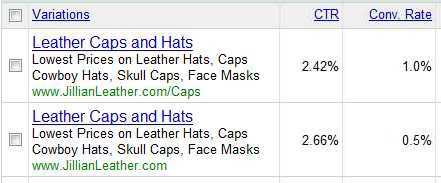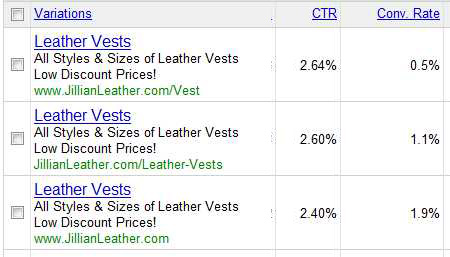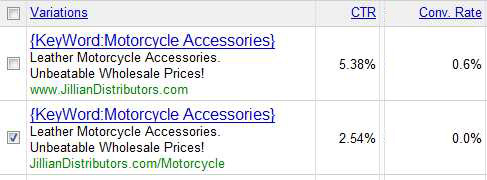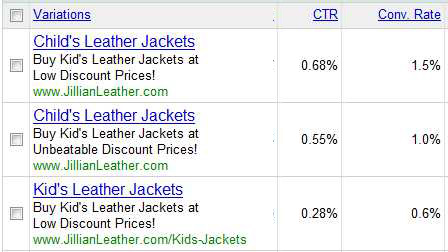Double Your Revenue By Testing Your Google Adwords Display URL
In eight years of operating an internet business, I've learned that small changes can yield big results. A lot of the internet gurus preach test, test, test, but don't offer real world examples to show you just how powerful a simple test can be.
Below are the results of a few tests I ran on the ads of one of my Google Adwords campaigns. These tests are the result of thousands of impressions and clicks.
One of the components of an Adwords ad is the Display URL. The Display URL is the url shown when an ad is displayed, but it has nothing to do with where the user is directed to when an ad is clicked. By running ads that were identical in every way with the exception of the Display URL, I was able to increase my conversions in some cases by more than 400%.
I ran these two ads in an ad group containing keywords focused on ladies leather purses and handbags. The ads used the same landing page and are identical in every way except the Display URL. The results of the test show the ads have a nearly identical Click Through Rate (CTR), but the ad that contains the word Purses in the Display URL converts 329% higher than the one that doesn't.
Here is another ad group where I got similar results. This ad group contained keywords that were focused on leather hats and caps. By adding the word Cap in one of the Display URLs, I suffered a slightly lower CTR, but I was able to double my conversion rate.
The above two tests show by adding a related keyword to your Display URL you can more than triple your conversions. However, if you relied solely on the above two tests to determine how you write your ads, you'd be leaving money on the table.
Here is a test I performed in an ad group focused on keywords related to leather vests. Notice how the ad that leaves out the keywords vest or leather vest from the Display URL has a conversion rate nearly 400% higher than the first ad. This is why it is important to test. Just because a technique works for one campaign, does not mean it will work in every situation. This is why testing is so important.
Here is another test that shows adding a related keyword to the Display URL cut the CTR in half and decreased conversions to ZERO!
The Display URL is just one portion of your ad that you should be testing. You should be testing everything from the headline, landing page, to every word in the ad. Here is another test I ran testing different ad components. Pay attention to how a small change can effect the conversion rate and CTR dramatically.
There are only a few products that I purchased that I would credit as significantly making an impact on my success as an internet entrepreneur. Perry Marshall's Google Adwords Course was one of these products.
This is where I learned everything I know about testing and Google Adwords. I can honestly say, I would not be where I am today had I not spent $50 and purchased his course. My business generated more than 1.3 million dollars in revenue last year. With that in mind, I think I can say it was $50 well spent!
Click Here To Sign up for Perry's Free Google Adwords E-mail Course Today!
Tags: ad testing, adwords, adwords guru, google adwords, perry marshall, PPC








That’s a very interesting study. Thanks for posting the results publicly. It ties in nicely with a report I just released a couple of days ago, showing the effect of using a generic domain name in the URL of a Google Adwords campaign.
The net result is that I was able to double the traffic from the campaign by using a generic that matched the keyphrases being targeted vs a non-generic “coined” domain, all other things (headline, ad copy, bids, landing page etc.) being equal.
I published the full results, including stats, graphs and analysis, on my site at http://www.memorabledomains.co.uk/ppc-generic-domains.html
@Edwin – Thanks for sharing your report. Were you tracking conversions? It would be interesting to see how conversions were effected in your test. As you can see from my test, the CTR was effected, but the conversions were effected dramatically. I really have no theory as to why this was since my test groups all use the same landing page.
I don’t think the average Adwords customer understands how important these type of tests are. If I’m getting a 1% CTR and you are getting a 2% CTR, I have to spend twice as much to get the same ad position as you. As you know, by increasing CTR you are effectively reducing your advertising costs and increasing your visibility to your potential customer.
One issue with testing multiple domain names, Google’s display url policy requires your display url to resolve to the same base url. For instance, you can’t have bicycles.com as a display url and have it resolve to bikes.com. You need a separate site for each domain you are testing. Dan Thies pointed out this could be damaging to organic results due to Google’s duplicate content penalty. He also gave a good solution in the same post that involved “no indexing” all but one of the domains.
http://www.seofaststart.com/blog/risky-advice-on-evading-adwords-display-url-rules
Another great post Dan wrote about Google Adwords testing can be found at this link.
http://www.seofaststart.com/blog/split-testing-adwords-youre-doing-it-wrong
I tracked conversions as far as the “Buy” page (since all I had was an Amazon widget and electric bicycles aren’t exactly impulse buys, no sales resulted from the test) and they certainly were no worse for the generic, but they weren’t statistically so much higher that it was worth including in the report.
If the site in question is a minisite independent of the “main” site, then perhaps a solution like I used would do – I simply rotated in a couple of page elements based on sniffing out the URL being visited in PHP, but the site was the same.
Unfortunately, because Google has now changed the rules on including multiple distinct domains within a single ad group, it’s no longer possible to set up a test like mine – I literally JUST scraped in under the wire before the rule change, racking up close to 100,000 impressions across the 3 test URLs.
This is a very interesting post, however I find it difficult to think that such a slight change to creative would affect conversion rate so extremely.
How much conversion and click volume exists for each of your testing cells in the above screen-shots?
@John – These tests were taken over a three month period. I only included tests that received at least 25 conversions in that time period. All the tests have at least 1,500 clicks and some as many as 3,500.
I agree with you. It’s hard to believe such a small change would effect conversions so dramatically. I don’t have any real explanation. You could argue that there isn’t enough test data and after 100,000 clicks we’d realize there wasn’t much of a difference in the ads. However, when I run the numbers through SplitTester.com it shows , “You are approximately 99% confident that the ads will have different long term response rates.”
I’m reaching here, but here is what I think happened.
When you split test a page, you are sending the same traffic source to at least two different versions of a landing page. You are trying to convince visitors who are browsing your offer to make a purchase. Split testing allows you to see what on page factors most influence your visitors to make a purchase, but you are sending the same group of people to different versions of the same page. In this situation, you would expect a small change to make a small difference, just not as dramatic as what I seen in my test.
An ad is a little different. I don’t think the ad itself had anything to do with convincing the visitor to make a purchase or not to make a purchase. I believe there was something about the small change in the ad that convinced an entirely different person that wouldn’t have clicked my ad, to click it and visit my site. There is something about the small change that separated the buyers from the window shoppers.
My only explanation is the small change doesn’t prove that one ad does a better job of presenting my offer. I do believe it proves that one ad does a better job of attracting buyers and the other does a better job of attracting window shoppers.
What do you think?
You say, “The Display URL is the url shown when an ad is displayed, but it has nothing to do with where the user is directed to when an ad is clicked.”
How does this square with Google’s URL policy?
@Randy – At one time, you could have anything you wanted for the display URL. It made no difference where the actual URL resolved. Google recently had a policy change that requires the display URL and the actual URL to resolve to the same domain. It only requires you to resolve the URL to the same domain, but it can resolve to any URL on that domain.
For instance, this would be acceptable.
Display URL: JillianLeather.com/Purses
Actual URL: AnySubDomain.JillianLeather.com/AnyPageOnThisDomain.html
This wouldn’t be acceptable.
Display URL: JillianLeather.com/Purses
Actual URL: AnotherDomain.com/Purses